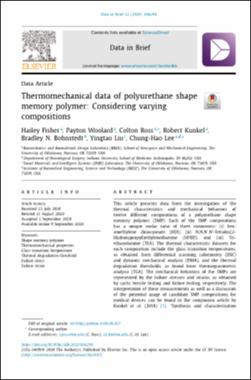| dc.contributor.author | Fisher, Hailey | |
| dc.contributor.author | Woolard, Peyton | |
| dc.contributor.author | Ross, Colton | |
| dc.contributor.author | Kunkel, Robert | |
| dc.contributor.author | Bohnstedt, Bradley N. | |
| dc.contributor.author | Liu, Yingtao | |
| dc.contributor.author | Lee, Chung-Hao | |
| dc.date.accessioned | 2021-01-07T21:01:44Z | |
| dc.date.available | 2021-01-07T21:01:44Z | |
| dc.date.issued | 2020-10 | |
| dc.identifier.citation | Fisher, H., Woolard, P., Ross, C., Kunkel, R., Bohnstedt, B., Liu, Y, & Lee, C. (2020). Thermomechanical data of polyurethane shape memory polymer: Considering varying compositions. Data in Brief, 32. doi: 10.1016/j.dib.2020.106294 | en_US |
| dc.identifier.uri | https://hdl.handle.net/11244/326702 | |
| dc.description.abstract | This article presents data from the investigation of the thermal characteristics and mechanical behaviors of twelve different compositions of a polyurethane shape memory polymer (SMP). Each of the SMP compositions has a unique molar ratio of three monomers: (i) hexamethylene diisocyanate (HDI), (ii) N,N,N′,N′-Tetrakis(2-Hydroxypropyl)ethylenediamine (HPED), and (iii) Triethanolamine (TEA). The thermal characteristic datasets for each composition include the glass transition temperatures, as obtained from differential scanning calorimetry (DSC) and dynamic mechanical analysis (DMA), and the thermal degradation thresholds, as found from thermogravimetric analysis (TGA). The mechanical behaviors of the SMPs are represented by the failure stresses and strains, as obtained by cyclic tensile testing and failure testing, respectively. The interpretation of these measurements as well as a discussion of the potential usage of candidate SMP compositions for medical devices can be found in the companion article by Kunkel et al. (2018) [1], “Synthesis and characterization of bio-compatible shape memory polymers with potential applications to endovascular embolization of intracranial aneurysms.” | en_US |
| dc.description.sponsorship | Funding from the Oklahoma Center for the Advancement of Science and Technology (OCAST, HR18-002) and the Oklahoma Shared Clinical and Translational Resources (OSCTR, NIGMS U54GM104938) are gratefully acknowledged. CHL was also supported by the institutional start-up funds from the School of Aerospace and Mechanical Engineering, the IBEST SEED Funding for Interdisciplinary Research, and the Faculty Investment Program from the Research Council at the University of Oklahoma (OU).
Open Access fees paid for in whole or in part by the University of Oklahoma Libraries. | en_US |
| dc.language | en_US | en_US |
| dc.rights | Attribution 4.0 International | * |
| dc.rights.uri | https://creativecommons.org/licenses/by/4.0/ | * |
| dc.subject | Shape memory polymer | en_US |
| dc.subject | Thermomechanical properties | en_US |
| dc.subject | Glass transition temperature | en_US |
| dc.subject | Thermal degradation threshold | en_US |
| dc.subject | Failure stress | en_US |
| dc.subject | Failure strain | en_US |
| dc.title | Thermomechanical data of polyurethane shape memory polymer: Considering varying compositions | en_US |
| dc.type | Article | en_US |
| dc.description.peerreview | Yes | en_US |
| dc.identifier.doi | 10.1016/j.dib.2020.106294 | en_US |
| ou.group | Gallogly College of Engineering::School of Aerospace and Mechanical Engineering | en_US |

